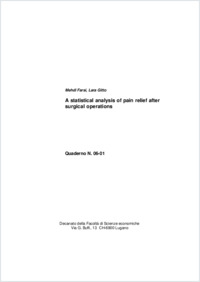A statistical analysis of pain relief after surgical operations
- Farsi, Mehdi Istituto microeconomia e economia pubblica (MecoP), Facoltà di scienze economiche, Università della Svizzera italiana, Svizzera
- Gitto, Lara CEIS Sanità, University of Rome Tor Vergata and University of Messina, Italy
-
2006
18 p
English
Adequate and timely application of analgesics after surgical operations is important from both clinical and economic perspectives. Administering pain relief measures requires information about development of post-operative pain and the effect of analgesics. Such information can be obtained from studying patients’ perception of pain in different periods after the operation. This paper applies an ordered response model to a sample of patients undergoing orthopedic surgeries. All studied patients have been received at least one analgesics. The patients’ subjective pain levels have been recorded for several intervals up to 24 hours after their respective operations. The adopted statistical model accounts for the unobserved heterogeneity among patients through random coefficients. Such heterogeneity could be due to differences in patients’ subjective measure of pain as well as their health status and sensitivity to pain. The analysis indicates that post-operative pain gradually increases over time but with a slightly diminishing rate. The results suggest that analgesics are quite effective in containing the development of pain. However, the analgesic effects manifest gradually, at a rate which is more or less similar to that of post-operative pain. This result implies that the optimal time of administering analgesics is immediately after the operation, suggesting preemptive analgesics could be most effective.
- Language
-
- English
- Classification
- Economics
- License
-
License undefined
- Open access status
- green
- Identifiers
-
- RERO DOC 5546
- ARK ark:/12658/srd1318021
- Persistent URL
- https://n2t.net/ark:/12658/srd1318021
Statistics
Document views: 165
File downloads:
- Texte intégral: 257
